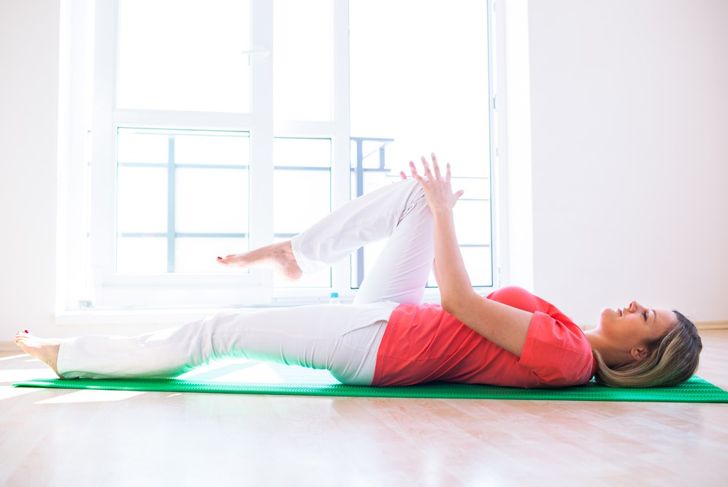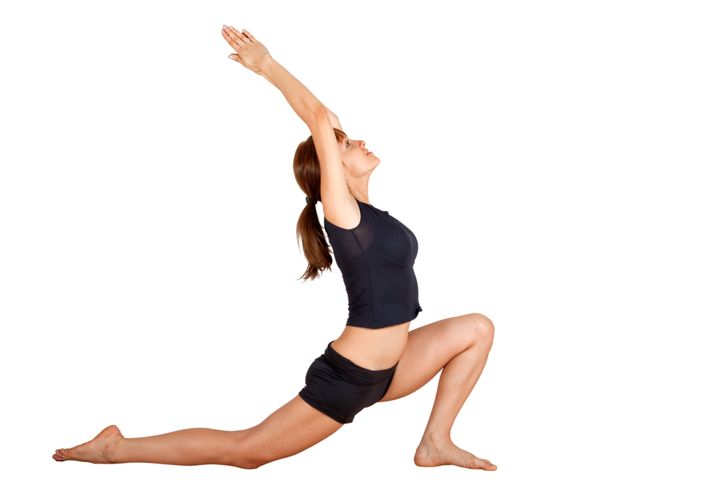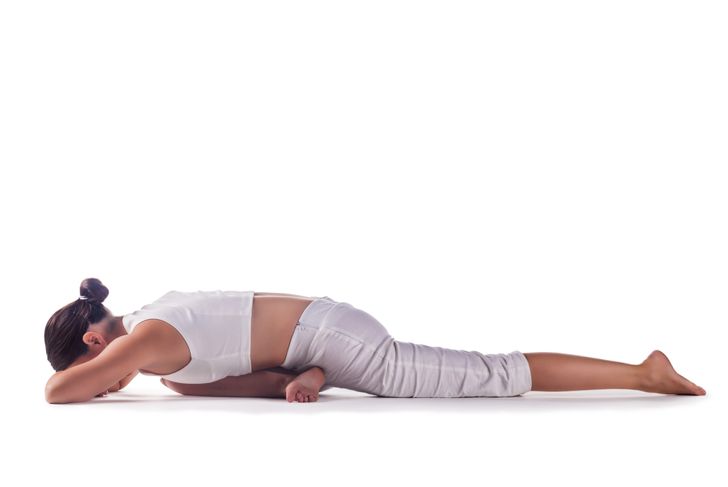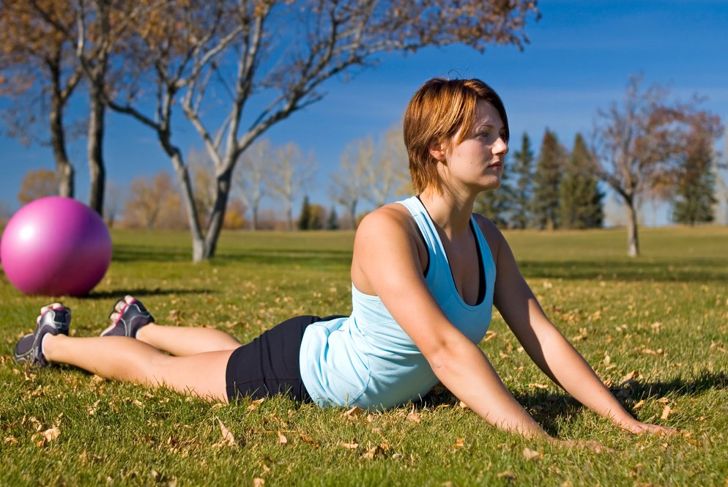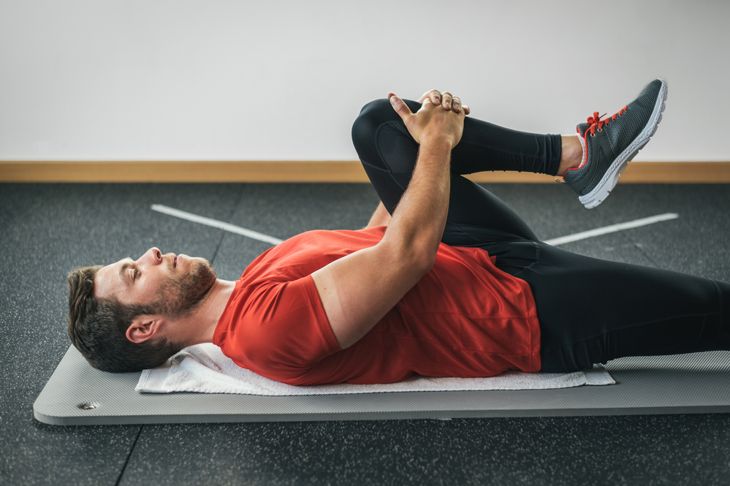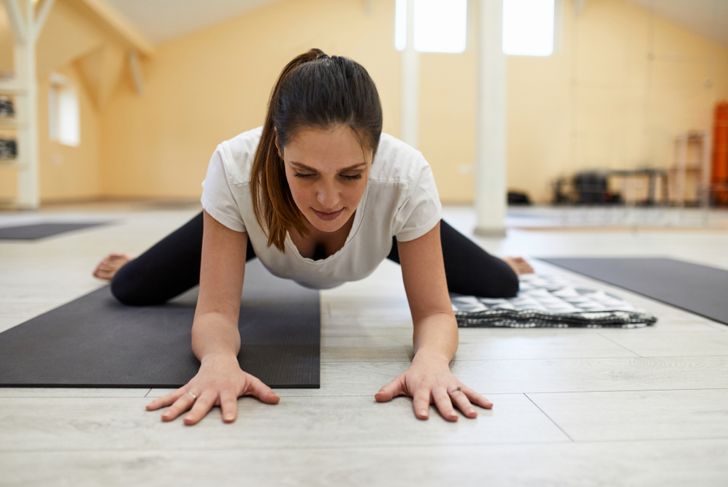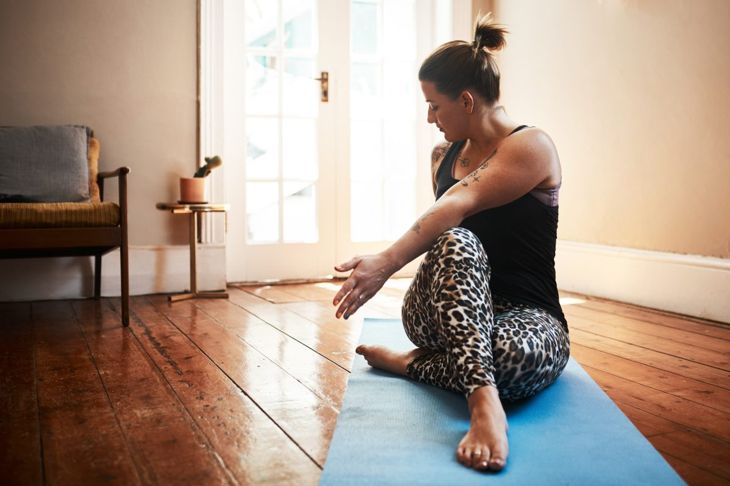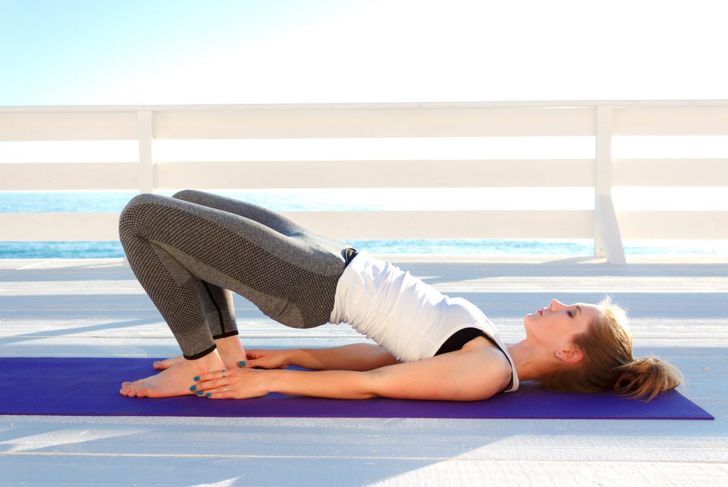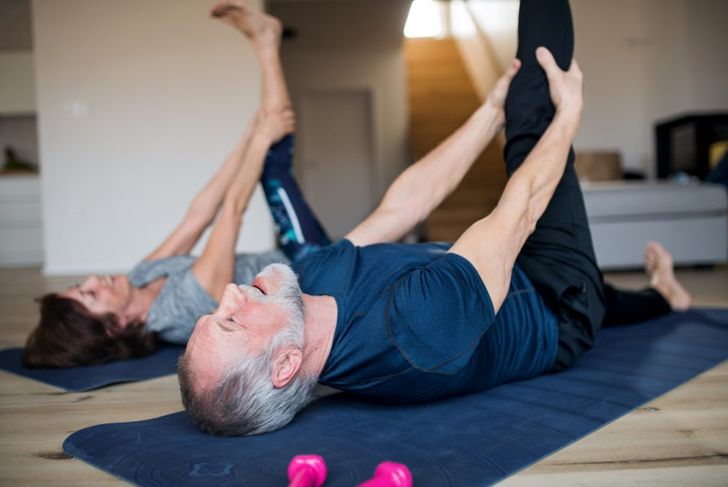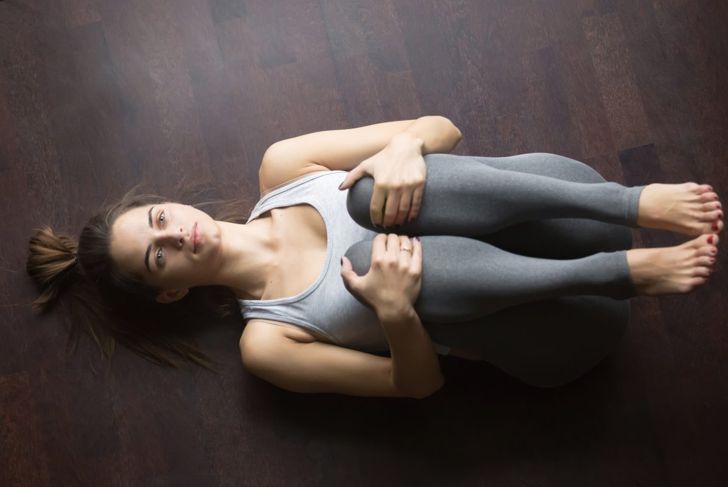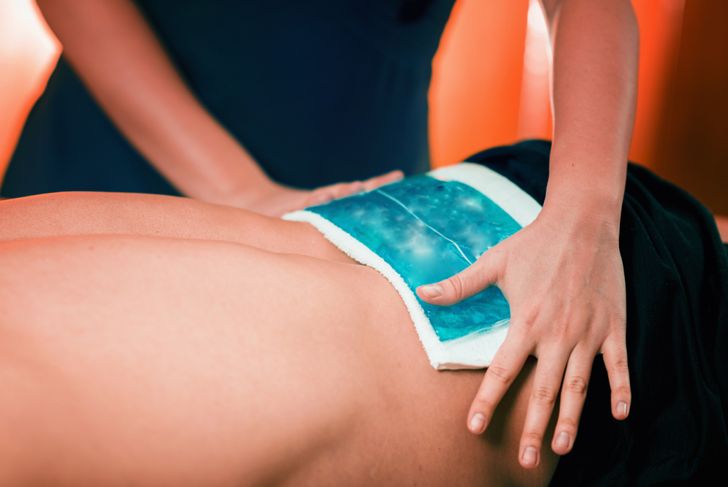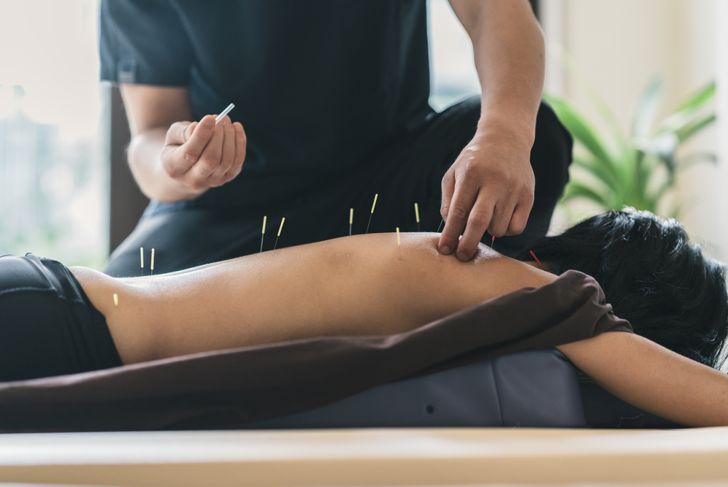Pain in the sciatic nerve can run from the spine to the leg. Most people feel the pain on only one side of the body. Though medication can help alleviate the symptoms, exercise therapy that aims to stretch the sciatic nerve and surrounding muscles can also offer relief and can serve as a useful supplement to allopathic options. However, check with your doctor before doing these stretches, and use pain as your guide. If a stretch worsens the pain, don’t do it.
Nerve Mobilizing Stretch
Lie on your back with your knees bent and a firm cushion or book under your head. Raise one knee toward your chest by grasping above your knee (lower hamstring) with both hands. From this position, stretch the leg toward the ceiling. Hold the position for 20 to 30 seconds, then return the leg to the ground. Repeat with the other leg.
Low Lunge
Kneel on the ground and extend one leg back as far as it will go, placing the top of the foot on the ground. Raise the knee of the other leg so the thigh is parallel to the ground, with the shin perpendicular and the knee directly over the ankle. Straighten your spine and raise your arms until the biceps frame the head. Hold the position for 20 to 30 seconds, then return to the kneeling position. Alternate legs and perform the same movement.
Pigeon Stretch
From an all-fours position, extend one leg back, placing the top of the foot on the ground. On an exhale, carefully lower the side of the forward leg’s shin to the ground, so the knee is behind the same wrist and the ankle is behind the opposite wrist (anywhere from right behind to the heel touching the other thing, depending on your flexibility). Keep the front foot flexed and if you feel pain in your knee, either move the front foot closer to the back thigh or prop up the front thigh and knee with cushions. Remain on your hands or lower down onto your forearms. Hold the position for 20 to 30 seconds, breathing evenly, and return to all fours. Repeat on the other side.
Back Extension
Lie on your stomach with your body stretched out straight but relaxed. Place your hands next to your head or just under your shoulders. Keep your neck long, looking straight ahead, and raise your torso by pushing your hands down. Keep your pelvis on the ground. Your upper arms should be at a 45-degree angle or so from the ground, depending on your back flexibility, and you should feel a gentle stretch in the abdominal muscles. If you feel pinching in the low back, decrease the back bend. Hold for two seconds and return to the prone position. Repeat this movement ten times.
Knee to Opposite Shoulder Stretch
Lie flat on your back with your legs stretched straight on the ground. Raise one knee toward the chest and position the shin parallel to the floor. Grasp the back of the raised leg, clutching above the knee with both hands, or around the outside of the knee if you can reach without straining your shoulders off the floor. Gently draw the knee toward the opposite shoulder, until you feel a stretch in the outer hip of the bent leg. Hold for 20 to 30 seconds, then release and repeat with the other leg.
Simplified Frog Pose
Start on all fours. Widen your knees into a comfortable stretch, keeping the ankles in line with the knees on both sides. With both shins still touching the ground, lower to your forearms so your weight rests evenly on the arms and thighs. Lower your forearms until your elbows touch the ground and your body weight falls onto your thighs and arms. Stay in this position for 20 to 30 seconds and then return to all fours. Repeat this movement a few times.
Hamstring Stretch
Stand straight and keep a stable object about a foot high directly in front of you. Raise one leg and place it on this elevated surface with your toes pointing upward and the leg straight, but without locking the knee. Lean forward over the raised leg, keeping the spine straight. When you are as far forward as you can go, breathe deeply and hold the position for 20 to 30 seconds. Repeat on the other side.
Deep Gluteal Stretch
Lie flat on your back with your legs straight. Bend one knee and place the foot flat on the floor. Place the other ankle over the bent leg, just above the knee. Grasp behind the knee of the bent leg and draw it in toward your chest to feel a stretch on the outer thigh or hip of the other leg. If this is too much of a stretch and the shoulders come off the ground, either leave the foot on the ground or prop it up on a block or the wall. Hold the position for ten seconds while breathing deeply, then alternate with the other leg.
Seated Twist
Perform the seated twist by sitting on the floor or on a stool. The feet should be flat on the floor. Cross the right leg over the left, and either wrap the left arm around the elevated knee or brace the left elbow outside it. Inhale and get tall, stretching the crown of the head toward the ceiling. On the exhale, twist — using the abdominal muscles and waist more than the arm — to the right. Hold this position for at least 10 seconds. Repeat on the opposite side. Do at least three sets of these twists several times a day.
Pelvic Tilt and Bridge
The pelvic tilt and bridge ease sciatica issues while stretching the back, thigh, and glute muscles. From the back, with the knees bent and feet flat on the floor, engage the abs, placing the hands on the ground beside the seat. There will be a slight motion as the pelvis curves toward the belly button. While holding this position (tailbone tucked), press into the feet and lift the pelvis toward the ceiling. The back should be straight, and the hands should be used for balance only. Hold the elevated position for five to 10 seconds, then slowly lower to the ground. Complete 8 to 12 repetitions, keeping the abdominals engaged throughout. When releasing, roll down slowly from the upper vertebrae to the lower.
Straight Leg Raise
The straight leg raise is often used to diagnose sciatica but is a useful exercise as well. Lie on the floor with one leg bent and the foot flat on the floor, the other straight. Engage the abdominal muscles and slowly lift the straight leg toward the ceiling, keeping the knee straight. Slowly lower and repeat several times before switching legs. Relax the shoulders as you do this, and do not reach or strain for the raised leg.
Back Flexion
Back flexion or knees-to-chest pose stretches and relieves the pain of many lower back issues, including sciatica. Lie on the floor with knees bent and feet flat. Raise the knees toward the chest and hold onto them (or behind the knees on the thighs), pulling them gently towards the chest. Focus on keeping the small of the back flattened against the floor. Hold this position to the count of 10, then slowly lower the legs to the starting position. Repeat up to 10 times, and do this stretch several times a day.
Abdominal Curl-Ups
While positioned on the floor, place the hands under the lower back. Both legs are bent, with feet flat on the floor. Engage the abdominals, bringing the belly button towards the floor. Lift the head and shoulders. Hold the position for three seconds, and slowly return to the starting position. Don’t try to do a complete sit-up, as this can place added stress on your back. Concentrate on good form. The range of motion in this exercise is small. Do 8 to 12 reps, and work up to three sets.
Strength Training
In general, building muscle is one of the best ways to prevent sciatica pain. Without regular exercise, conditions like sciatica become more common and are typically more severe. The back and core muscles are integral for maintaining proper posture and alignment, so exercises that target these areas are best. Make sure to include plenty of stretching. Read on for more practices that can help ease sciatic nerve pain.
Apply Heat/Cold
Temperature treatments are useful for improving sciatica pain. For the first week, use ice packs or other cold options to reduce inflammation. Do not allow an ice pack to directly touch the skin and use them for only 15 to 20 minutes at a time. Introduce heat after the first week, once the pain starts to diminish. Some people prefer heating pads, while others like to use a warm bath. Apply heat for at least 15 minutes, but no longer than a couple of hours.
Topical Treatments
Many people find that topical medications provide quick relief from their sciatica pain. A range of different ointments, creams, and gels can help reduce inflammation and numb the nearby area. Some options may irritate the skin or cause an allergic reaction, so remember to spot test first on a small section of the body. Research indicates that applying topical medications to warm skin can diminish their effects, so do not combine them with heat packs or similar options.
Be Active
People tend to remain in bed or relax in a chair when their sciatica pain flares up. While resting for the first few days after sciatica pain develops is fine, remaining sedentary usually does more harm than good. Moving around helps strengthen the muscles, improve flexibility, increase blood flow, and reduce the perception of pain. If moving seems to make the sciatica pain worse, visit a healthcare professional.
Consider Complementary Treatments
Seeking additional assistance alongside other treatments can help alleviate sciatica. Physical therapists can not only provide a rehabilitation program to prevent future issues, but they can also offer advice specific to each case. Some people prefer options outside the realm of standard medicine. For example, some studies suggest that acupuncture may help with back pain, including sciatica symptoms.

 Home
Home Health
Health Diet & Nutrition
Diet & Nutrition Living Well
Living Well More
More